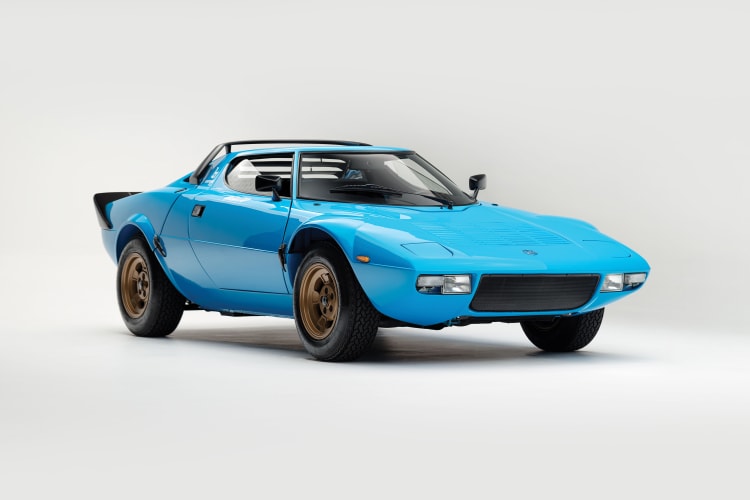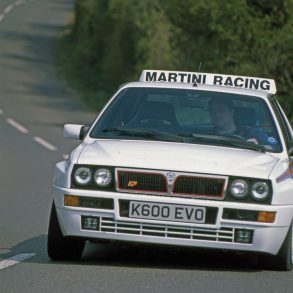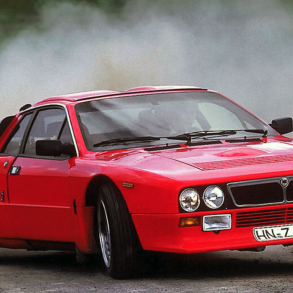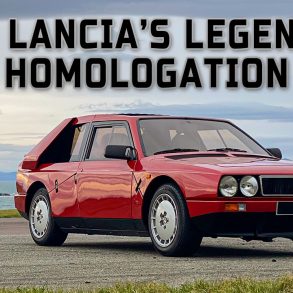It’s common knowledge that top-tier competition cars often have little to do with ones we see on the streets, yet there was rarely a car as specific as the Lancia Stratos HF. The wedge-shaped wonder was a continuation of decades of innovation and a forerunner of a new era in the space age; colder, more isolated, and completely detached from the apple pie optimism of the 1950s.
With its sci-fi presence and groundbreaking performance, the Stratos truly lived up to its name, making each of its adversaries dated and prosaic. On the rallies, it didn’t only outshine the Escorts and the BMWs with its looks, but ferocious performance, and those lucky enough to gaze at the car dancing around were blessed to witness one of the most mesmerizing performances in pre-Group B era.
Without a shadow of a doubt, Lancia Stratos HF holds a place in the automotive hall of fame, keeping Lancia forever safe from falling into oblivion. To that end, it’s our turn to pay tribute to this legendary marque and one of its brightest stars.
Background to the Lancia Stratos HF
From its very beginning, Lancia has been a lovable Italian oddity and a brand quietly pushing the boundaries of automotive engineering, introducing numerous solutions decades before they became industry standards.
Unibody chassis and independent suspension were just some of them, and the fact that they were introduced in the early twentieth century makes Lancia even more special.
Later on, Lancia brought the first production V6 and V4 engines, five-speed gearbox, independent suspension on both axles and rear transaxles for its rear-wheel drive cars. Constant striving for innovation

Interestingly, Lancia tried to maintain the image of a composed, intellectual brand of aristocratic demeanor. In the 1950s Lancia briefly ventured into Grand Prix racing under Vincenzo Lancia’s son Gianni and Vittorio Jano, later merging with Ferrari, yet it rarely utilized its advanced cars for other forms of competition.
The brand found its ground in rallying thanks to Cesare Fiorio, a keen racer, and skilled manager who joined Lancia in 1963. Soon, Fiorio established the HF Squadra Corse, a factory-backed team of enthusiasts that started rallying on a small scale, competing in local rallies in prepared Flavias, soon growing into a formidable racing department and official Lancia works team in 1965.

HF stood for High Fidelity and Lancia being Lancia, it chose an elephant as its symbol. Many would argue that a leaping elephant wasn’t an adequate representation of Lancia’s light and agile sports cars, but the largest land mammal was a symbol of victory. Moreover, Gianni Lancia proposed it because once an elephant started running, nobody could stop it. To a certain degree, this is true because Lancia is cherished as one of the greatest forces in rallying even though it barely exists a brand today.
Development
One would say that a car as peculiar as the Stratos could only be born out of pure passion and playfulness, but the truth is almost exactly the opposite. After years of struggle to keep afloat with its high quality standards on a small production scale, Lancia was taken over by Fiat in 1969.

Under new ownership, the management needed a project to justify its newly established image of a rally trailblazer, courtesy of Sandro Munari and the swift Fulvia HF. Driven by seasoned squads, the Fulvia HF outright dominated the Italian Rally Championship and in 1972 conquered its first World Rally Championship, but the eyes of Lancia’s heads were already gazing somewhere else.
In his own small battle with Pininfarina, Nuccio Bertone aimed to take over designing and coachbuilding Lancia cars, making a perfect car to show off the ingenuity of his design studio.
He took a Lancia Fulvia owned by his friend, stripped it to its bare chassis, rearranged the layout, and let Marcello Gandini play. What soon resulted was a concept car so radical it became a pivotal point in 20th-century automotive design.

The Stratos HF Zero was low, sharp, and hostile, breaking the tradition of curved forms, completely obliterating them for the next two decades.
Before showing it to the public at the 1970 Turin Motor Show, Bertone brought the car in front of Lancia headquarters. Security ramps were no obstacle for the Stratos Zero – it passed right under them. Not unexpectedly, every soul present that day was thrilled, fully aware that they’re witnessing the future firsthand.

After negotiating with Cesare Fiorio, Lancia’s general director Pierrugo Gobbato was convinced to greenlight the Stratos project and Bertone was of course onboard.
The development of the new rally car commenced in 1970 under Sergio Camuffo and Giovanni Tonti. Among the engineers were Lancia’s veteran Francesco De Virgilio and Nicola Materrazi, a young engineer who was later to become one of the most visionary constructors on the Italian racing and sports car scene.
Technical director of Lancia’s racing division Giovanni Tonti briefed Bertone’s Marcello Gandini on making a car less extravagant than the Stratos Zero, yet still distinctive and considerably more practical for rallying.

From the start, the car was conceived as a compact mid-engined sports car built on the very limits of rallying regulations of the era. In 1971, Gandini came up with the Stratos HF prototype sporting fluorescent orange color, alien looks, and 2.4-liter V6 from the Dino 246, a powerhouse deemed ideal by Lancia’s technical directors.
The choice of a powerhouse for the production model varied greatly, as Lancia had to rely on outside suppliers and Ferrari wasn’t initially interested in any sort of cooperation.
Announcing that the production Stratos HF certainly won’t carry the powerhouse from Maranello, Lancia considered Maserati engines, yet the tables soon turned in its favor.

The year 1972 was a breakthrough year for the Stratos when Enzo Ferrari finally loosened his attitude towards supplying the engines. After Fulvia triumphed at the 1972 Rallye Monte Carlo, Ferrari called to congratulate Gobbato and personally break the good news.
The first batch of ten engines came to Lancia Squadra Corse for tuning and preparations for the Stratos HF’s rallying debut. When the car first competed at the Tour de Corse, it was still a prototype but could still compete thanks to the then-current set of rules stipulating that 500 examples had to be made in the period of 12 months since the debuting event.
By the end of 1972, Gobbato put more pressure on Fiat heads who managed to persuade Enzo to supply the engines. Finally, Lancia was granted a supply of 500 engines.

In the meantime, the minimal homologation number was revised to 400 and the Stratos was homologated in October 1974. Sources claim that a total of 498 cars were completed until as late as 1978 or even 1979 when the last pieces were assembled from leftover parts.
Chassis
The skeleton of the vehicle had to be optimized for battling tough terrains and protecting the occupants in inevitable shunts and crashes. The chassis had to offer phenomenal strength and rigidity in a compact package that’s also as lightweight as possible.

The chassis design was carried out by the accomplished constructor Gian Paolo Dallara and a talented British ex-racer and engineer Mike Parkes. The engineering duo came up with a steel monocoque with steel front and rear subframes and space-frame construction with an integrated roll-cage.
The proportions of the chassis were optimized for rallying, a wide frame coupled with short wheelbase and overall length meant that the car was engineered to effortlessly turn on a dime, a must for every legitimate rally car.
Body
The production variant of the Stratos HF didn’t differ much from the 1971 concept car with just a few alterations to make it production-friendly.


After considering aluminum, the material of choice for a concept car, the engineers opted for a fiberglass shell as the lightweight material was less costly to produce and better suited for mending between the rally stages.
While its design was so utterly impractical even for sports car standards, the vehicle was still profoundly functional as a rally car. The front and the rear hood were two clamshell panels, spreading open to provide the mechanics with unobstructed access to the car’s internals.

The production Stratos had a slightly reworked front and the back end featured smaller lights taken from Fiat’s part bin, but none of it could hamper its unique charm.
Even with all adjustments and cost-saving compromises, the vehicle was still more of a wild design study than a production car and hardly any rally automobile was ever as innately radical as it was.

The aerodynamic front was a sharp and square wedge continuing into a wide curved windshield glass, a suitable feature for a car designed to be tossed around sideways in each and every corner.
The Stratos wasn’t a typical wedge car of its era though, as its generously curved side profile raised drastically, creating an atypical silhouette that no brand ever tried to replicate.

The Stratos basically looked like a vile space module straight out of a sci-fi show. Its short wedge profile and wide staggered stance were intimidating from every angle, whether it was the sharp and generously grated front or the exaggerated back with exposed dual exhausts and a massive matte ducktail wing.
To further emphasize its alien-like charm, the Lancia Stratos HF was finished in a palette of vibrant and zesty colors, complete with painted wheels.
A total weight of the Stratos HF was around 2160 lb, while the competition cars endured even further weight reductions, weighing around 1,940 lb.
Engine
As told, Enzo was at first reluctant to procure the engines to Lancia, seeing the Stratos as a potential competitor to the Dino. But as the junior Ferrari range made a switch to V8 powerplants, the car got the powerhouse it was intended to have since the concept stage.

The engine in question was the Dino, a 65° V6 co-developed by Alfredo ‘Dino’ Ferrari and Vittorio Jano, the ex-Lancia engineer and the co-creator of Lancia’s own pioneering V6.
The 2.4-liter variant of the Dino featured a cast-iron block, aluminum heads, and triple Weber carburetors. In the Stratos HF, it was transversely mid-rear-mounted and mated to a Ferrari 5-speed dogleg gearbox with a ZF limited-slip differential.

In street-legal Stradale trim, the Stratos HF had a power output of 188 horsepower at 7,000 RPM and 166 lb-ft of torque at 4,000 RPM, just a few horsepower shy from the 246 Dino, but with peak torque available at 1,000 RPM lower than the junior Ferrari.
Even in Stradale form, the 2160lb vehicle offered vigorous performance, but that was just the start for the Dino V6. For the lightened HF Squadra Corse cars, engineers reworked the engines to produce around 270 horses in 12-valve variants, while subsequent versions of the rallied-up Stratos had 24-valve cylinder heads and a power bump to over 300 horsepower.
In both configurations, the Stratos was a dominant force, prompting temporary restrictions of four-valve heads until the competition caught up with the technology.
Suspension and Steering
Probably more than in any other form of racing, performance suspension is of crucial value in rallying. With that in mind, the car featured fully adjustable front double wishbones and rear MacPherson struts, a setup restricting the movement of the rear axle in favor of damping the rough terrains via its lighter front axis.

Truth be told, the steering wheel in the Stratos HF was almost obsolete. The car had an extremely short wheelbase and was so throttle happy that drivers steered it by dosing the power from the screaming Dino V6 engine. Nonetheless, the vehicle had rack and pinion steering with 3.25 turns from lock to lock in Stradale and 2.5 turns in competition form.
Brakes, Wheels and Tires
As the wheels, the brakes differed too. The Stradale had the ATE all-disc brake system whereas the WRC-competing cars boasted Lockheed brakes with 4-piston calipers on both axles.

The car had two basic wheel designs: the Stradale variant had 14-inch Campagnolo magnesium wheels on beefy high-performance radial 205/70 VR14 Pirelli CN36 rubber.
The competition versions had larger 15-inch five-spoke Campagnolo ‘coffin-spoke’ magnesium wheels measuring 15×8 inches in the front and 15×12 inches at the rear.

Lancia Stratos HF Interior
Contrasting the wild exterior was the minimalist cockpit engineered to feature nothing but bare essentials.
The cramped interior was simplistic to the core with the seats and the steering wheel being the only elements designed beyond providing baseline functionality.

As with many sports cars of the era, the pedals were noticeably offset towards the center, whereas the simple dashboard featured a cluster of dials reading vital parameters, most of them sourced from Fiat.
Interestingly, Lancia put the speedometer and the rev counter to the right, partly obscured by the steering wheel, placing oil and water pressure gauges and fuel gauge directly in front of the driver. Although it didn’t seem logical at first, the instrument layout was suited for rally drivers who had more use of these parameters.

The door cards were flat, with nothing but door handles and two panels designed specifically as a resting place for racing helmets. The windows opened only halfways and didn’t even crank – they were operated via a simple slider.
The Stratos’ interior is usually perceived to offer plenty of room for hands and elbows in favor of notably restricted legroom and headroom.
Lancia Stratos in Racing
By now, you’d probably expect that the car as meticulously prepared for its goal of dominating on European rally stages, took the racing world by storm, but reality sometimes bites in unexpected ways.
The Stratos had its first outing with Sandro Munari at 1972 Tour de Corse under Dallara’s management, but its appearance, as well as the next two, were plagued with issues. The increased power of the car was too much for rear uprights.
After addressing these issues, the Stratos quickly picked up the pace. Taking the first major win for the vehicle came in 1973 at the Tour de France Automobile, thus opening the doors to years of success. The car scored three back-to-back WRC titles in 1974, 1975, and 1976.
Sadly, Fiat pulled the plug on the Stratos by choosing to promote its Fiat 131 Abarth, but that didn’t prevent the car from continuing to win in the hands of capable privateers with well-organized teams.

The Stratos HF scored its last WRC win in the 1981 Tour de Corse, raking a total of 18 first-place podiums from 1974 to 1981.
In addition to WRC victories, the Stratos HF was particularly successful in two major events, Tour de France Automobile which it won five times (1973, 1975, 1977, 1979 and 1980) and Giro d’Italia automobilistico where it triumphed three times, in 1974, 1976 and 1978.
After Sandro Munari, the name most closely associated with the car was Bernard Darniche. The French ace scored for WRC victories in the vehicle as well as four out of his six victories at the Tour de France Automobile.
Apart from rallying, the vehicle outed in endurance racing under Group 5 regulations. The modified Group B Stratos Silhouette was re-engineered by Nicola Materrazzi and it featured an aerodynamically efficient body and a turbocharged engine. This variant of the car had mild success, in part due to the fact that they were pitted against Porsche 935, one of the most dominating race cars of the era.
Valuation of the Lancia Stratos HF
| Condition | Value |
|---|---|
| Concours | $685,000 |
| Excellent | $617,000 |
| Good | $545,000 |
| Fair | $455,000 |
Legacy
In more than one way, Lancia Stratos made an everlasting mark on the automotive world. By being the first uncompromisingly engineered WRC car and by consequently dominating the sport, it single-handedly radicalized rallying, making it increasingly experimental, ultimately paving the way to the brand’s own Lancia 037 and the Delta S4, as well as Audi Ur-Quattro, Peugeot 205 T-16 and other superstars of the 1980s.

Given that the nature of its primary purpose didn’t allow all 500 examples to survive made the Stratos HF a desirable classic. Nowadays, as a cherished collector car, it is an example of a space-age design that made it to production in virtually an unblemished original form.










